Hello,
I'm new here and also new to making bread and baking in general.
I've tried making sourdough bread a few times and thought the end product loaf came out good, I can't help but feel frustrated that my dough never comes out glossy elastic like I see in every single video/dough making pictures.
I've tried making pinsa today and the dough I ended up with was tearing/almost felt too wet on the surface (like the water didn't get incorporated although I was kneading and then slap folding for quite some time.. But the dough never got elastic)...
I've stumbled upon a video showing a comparison of a well made dough and a badly made one. And the bad example looks exactly the same as the dough I got every time I made sourdough bread and then again today when making pinsa. To my bad luck, I can't speak italian, so I'm bot really sure what the thing to be careful about is, or what I am doing wrong.. Am I adding water too fast, or just too much? Can a dough like this be salvaged?
Here's the link to the video: https://youtu.be/3LLYtZ-heCM (sorry, using the image icon and web to add the link wasn't working - it said it can only be used for images)
Please help me make a decent dough like I've been used to seeing all around :)
Thank you!
P.s. I decided to post the topic in the sourdough section because I think it might have something to do with high hidration doughs.
I found this: https://www.thefreshloaf.com/node/12269/dough-tears-when-kneading
To add, I've used 104% hydration dough and haven't really experienced tearing much so I don't think it's a hydration issue. You should also post your recipe to get help with it. There are lots of pros on here, I'm just a newbie.
Thank you for the link, I'll definitely keep resting dough for a bit if it starts getting too sticky next time.
Hello Rosemary,
welcome to The Fresh Loaf!
You have mentioned kneading AND slap'n'folds. Why both? If you knead in a machine (bread machine, food processor, bread mixer) then you don't need to slap'n'fold. If you knead by hand, then how does it differ from slap'n'folds? Kneading by hand IS slapping and folding dough.
The major difference between what you see in the video and what you are doing might be
1) the choice of flour, your flour being different from what the videoblogger uses. If their flour is different from yours you won't achieve the same result.
2) you are assuming that mixing by hand is the same as mixing in the machine. These two methods are different as sky and earth, you won't achieve the same results.
A different flour is a handicap to overcome or to account for. A different kneading method is a handicap as well, if you knead by hand but not doing 600-800 slap'n'folds, or kneading by hand when you need to use the machine, will lead to different results.
Sourdough or not is irrelevant. It can be sourdough, yeasted, soda, or plain, without any leavener at all. It's the technique of incorporating water into flour and the technique of kneading that matters to achieve the result that you want.
The proper technique that the Italian guy is showing in the video MAGLIA GLUTINICA - Quanto conta? that you are linking is the method of two step or multiple steps of water addition. First, you add a little water, mix to homogeneity. Make sure your water is ICE cold. Pinsa requires ice cold water and dough temperature should be very low, below 20C, quite cold to touch.
Then knead that dough, until it is smooth and shiny.
Then add a little more water. Knead, until it is smooth and shiny.
Then add a little more water, Knead..
etc.
Until all water is incorporated.
The lesson here is
1) make stiff cold dough and let gluten form, protein molecules come together and link. Then develop gluten (knead, stretch it, apply energy to it), knead until your dough is smooth and shiny BEFORE you add the remaining water, either in one step, or in multiple tiny steps.
2) knead as you add more water (or liquid sourdough starter), if by hand, then you would have to let dough rest in between those tiny addition of water. Like so
https://www.facebook.com/ceorbread/videos/1801473596846582
Can a dough like yours be salvaged? Yes, of course. Let it rest, refrigerated, for as long as it needs to form more gluten and to absorb whatever liquid you have added. For a hand kneaded dough, if screwed, it might need as long as a day or two in refrigerator, as shown here for pizza romana by hand, but it will come together and become smooth and shiny and non-sticky eventually.
The proper procedure for pinsa dough is shown here. Click on the tab Procedure and Leavening
It is not even that wet, only 77% water (770g water per 1000g flour, or, as they say 1 liter water for 1.3 kg flour), but even at that level, water is incorporated in two steps. First, to form a normal consistency dough with 3/4 of all water, knead it for a long time until gluten is formed and then developed until shiny and non-stick. And only after that in tiny increments the remaining 1/4 of water is introduced and is kneaded well again.
Oh waw, I really wasn't expecting such a detailed and thought through reply, thank tou so much mariana!
Upon reading your reply and looking through the videos/forums you've posted and then something other, I think my main problem is the kneading technique in combination with not incorporing the ingredients enough.
When I said I kneaded and then preformed S&F I meant - I started out mixing the dough in my stand mixer but after cca. 5min it started sounding like it was really struggling, so I've decided to continue mixing by hand. After I got a decend shiny dough (this was 65% hydration) I made a few cuts in the dough and added oil, salt and a splash of the ramaining water to be added. This step seemed to be taking forever as I could feel the bits of salt still not being distributed in the dough. After that I added more and more of the remaining water - mixing in between, but I guess I was adding it too quickly. The dough felt very slippery and I just couldnt mix it well in the bowl - I was clenching, folding, tried the rubaud method (sounds more like taking frustration out on the dough now that I'm writing this lol).. I tried everything to get it incorporated and shiny, but the dough just wasn't getting there. So I transferred the dough from the bowl onto the tableand continued with some S&F there.. The dough actually got to the point it was actually not stretchy anymore, although it wasn't getting glossy. (from what I think I've learned, I should have let it rest at this point) but instead I think I remember trying to knead the dough some more because it felt like it didn't develop enough gluten (couldnt stretch it without tearing - windowpane test). What I should have done was let it rest for 10 min and do another set of SNF? And repeat until it got stronger.
That's why I ended up with gooey dough that felt luke it was turning into gum under my hands lol... In the end I somehow managed to get it to come together again, barely. I'll include some pics of the pinsa after baking.
Oh, some things ng else I've been thinking about.. What I was confused about after watching the videos in the reply was, why is it so important to add the remaining water gradually, why not just add all of it in the begining? The 'no knead method' showed you can add all of the water at once and that was almost 80% hydration and he ended up with really nice dough. All of the sourdough recipes I've read never added the levain gradually neither, always all at once?
Thank you again for your effort with the reply, I really appreciate it!
Oh right, here's the recipe I followed :
Rosemary,
the recipe that you linked is neither sourdough, nor double hydration (or high hydration). It's a recipe for a very dense no-knead dough. This man shows his pinsa's white underbaked bottom and tight crumb at 5:55 min
His pinsa toppings are very beautiful, though. Very nice.
In the previous video that you linked, two ways of adding water were shown: little by little and all at once methods and they discuss two things:
1) gluten formation
2) gluten development.
And he explained (in Italian) that the second method doesn't let gluten form. If there is no gluten, there is nothing to develop!
When you first moisten flour with water, gluten forms. The best conditions for that is relatively cold dough and relatively little water - to have a medium consistency dough.
With time, flour particles will become moist throughout and gluten will form.
Depending on flour, it takes between 20 min and 3 hrs for gluten to form fully. Gluten is different protein molecules linked together into a network.
When you add more water INITIALLY, i.e. mix a very soft dough right away, protein molecules can't even find each other to link together into gluten network. They are separated by many water molecules between them. So, if you mix a very high hydration dough right away, it is very difficult to make it into a non-sticky shiny dough with large open pores and strong structure. It would probably stay liquid, like pancake batter, not like a piece of dough that you can hold in your hands and shape into tall loaves without dough sticking to everything in sight.
So, when ciabatta was first invented by Italians, the double hydration method was invented as well. In that method, first, a normal piece of dough is mixed, flour well hydrated and gluten formed and developed into thin layers of protein networks with air bubbles trapped in it (future bread pores). When flour particles are not well hydrated throughout yet, the dough surface would look dull, matte. When they are well hydrated due to time and thorough rubbing/kneading, and gluten has formed and developed, it shines, moist throughout, glossy gorgeous.
Then the second portion of water is added which disrupts gluten, making it look like porridge, as you noticed, and the dough is stretched (kneaded in the mixer, where it is stretched by the hook) or slap-n-folded hundreds of times by hand, to make those gluten proteins find each other again and link together.
Like so: orange are long gluten molecules linked by black bonds into huge networks. Water gets in and disrupts bonds and relaxes dough, it is no longer compact, it flows.
With bakers pursuing even higher hydration in dough pieces, up to 120 g of water per 100g flour, plus moistening it with oil, if it's for pinsa or focaccia, the method of continuous hydration was developed. Here, we try to not disrupt much to begin with and add liquid ingredients bit by bit, drop by drop as we mix dough. The whole process lasts practically as long as the dough ferments. It takes many small liquid additions this way, but the gluten forms and forms the whole first three to six hours and is practically never disrupted much.
If you add too much water at once, the solution is to give it about 400 slap-n-folds. Wear gloves, keep your dough cold and slap it away. If you have a mixer or food processor, so much better - add ice and knead on high speed. This would be an example of true 'double hydration'. When our mixer does it, it looks easy and doesn't take much time to whip it back into shape on high speed, but by hand double hydration is very challenging, because you would have to energetically slap and fold it for about 20-30 min non-stop vs 30 seconds in food processor. It's exhausting.
See how it looks here, starting at 4:10 when water is added to an already hydrated and kneaded piece of dough and then slapped and folded 400 times until incorporated and non-sticky.
Continuous hydration is much easier and can be done both by hand and in a bread machine or food processor, if you don't have a mixer that can handle bread dough.
The no-knead method with 80% hydration, where all water is dumped at once relies on the fact that that water is not blended with flour. There is no mixing, no rubbing, no whipping. It looks very shaggy, clumpy, with dry bits here and there. So protein molecules will find each other in that shaggy mess in less hydrated places and will form gluten and then they will have time to form all gluten possible and slowly stretch under gas pressure, because highly hydrated no-knead doughs require between 24-48 hrs to nearly full week of very slow hydration and fermentation for best results.
Levain, whether stiff, soft or liquid is not just water, you add flour as you add levain. It is already a portion of dough with flour particles fully hydrated and proteins having formed gluten (or not, in case of liquid levain). So, adding levain to a piece of stiff dough will not harm its gluten structure too much. It will ether strengthen it (stiff levain has lots of strong gluten), leave it as is (soft levain), or weaken it a bit (the purpose of liquid levain).
I'll be waiting for the pictures of your pinsa, Rosemary. I wish you the best.
m.
I've also noticed the dough in the video looked much stiffer then the one I ended up with - I thought it was only due to poor gluten development in my dough. Otherwise I thought 75% is considered a high hydration? I guess maybe I was wrong :)
Ingredients I used were:
- 500 g AP flour
- 375 g water (of which I reserved 25 g to be added subsequently)
- 10 g olive oil
- 10 g salt
- 3,5 g fresh yeast (edited , whoops, forgot to mention this ingredient xD)
Basically half of the ingredients in the video.
I forgot to mention I added some more flour after first 2 h of ambient fermenting and kneaded (or at least attempted to) a bit more to get the flour incorporated.. that's where it got sticky like over chewed chewing gum.. I realize this wasn't the best approach, but it was all I could think of at that time of crisis x) I somehow managed to make it come together again by preforming some slap and folds.
Anyways, after that, the dough went into the fridge for about 20 h, after which I took it out for about 1 h to get it warmer before taking away 300 g of dough, "shaping it" into a boule and letting it rise for another 3 h. Then I just let the dough fall out onto a semolina floured surface and shaped it as gently as I could into a pizza shape. Baked it on max (cca. 225) with ventilation on lowest rack for 7 min, took it out to add toppings and baked it again on the highest rack for another 5 min or so. (that was yesterday - I didn't know how to include pics as I was writing from my phone then).
Today, I took the remaining dough out (it's been 45 h since the first time it was put in the fridge) and will wait again for 1h before dividing it into 300 g pieces. I will then do everything in the same manner as yesterday, an freeze the remaining boul/s for next weeks attempts x) I'm thinking about baking it in the middle rack for the whole time without ventilation, again on max. The crust was very crunchy, almost dry yesterday, so I'm not sure whether it's just the dough or did the ventilator dry it out a bit too much. Then again I know there's only as much you can get from a 225 C oven (either white or dried out dough). Or should I stick with the vent on for a more uniform heat dispense anyway?
I'll take some pictures along the way again today and post them later on.
So if I understood correctly, there are 2 approaches to mixing high hydration dough.
Either by firstly mixing a 60 - 65% hydration dough and forming gluten well, and then slowly incorporating more and more water, little by little (either as in double hydration method or continues method (which is a bit different as you don't form a well developed dough but rather add more and more water as you preform Str&F thruought the bulk / or primary ferment (sorry, not sure here))),or
mix the whole water at once and preform multiple stretch and folds with many long rests in between until gluten is formed and then do the bulk ferment in the fridge for a longer period of time.
Is there a difference in taste and crumb structure between the first (where added gradually) and second (where mixed all at once)?
Here are the pictures from yesterday's pinsa/pizza:
Image
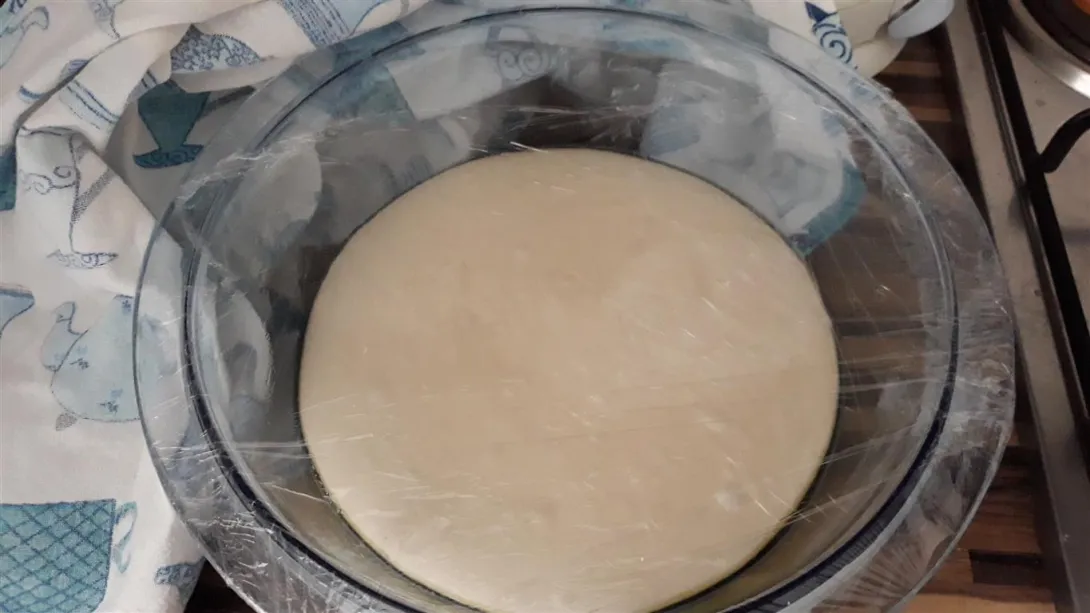
Image
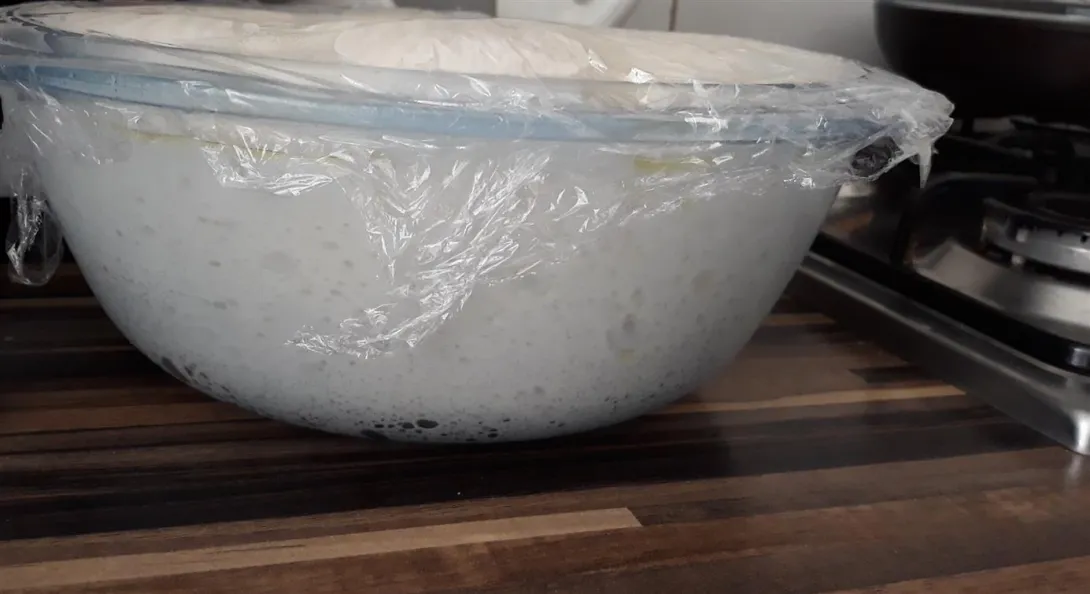
Image

Image

Image

Image

Image

Image
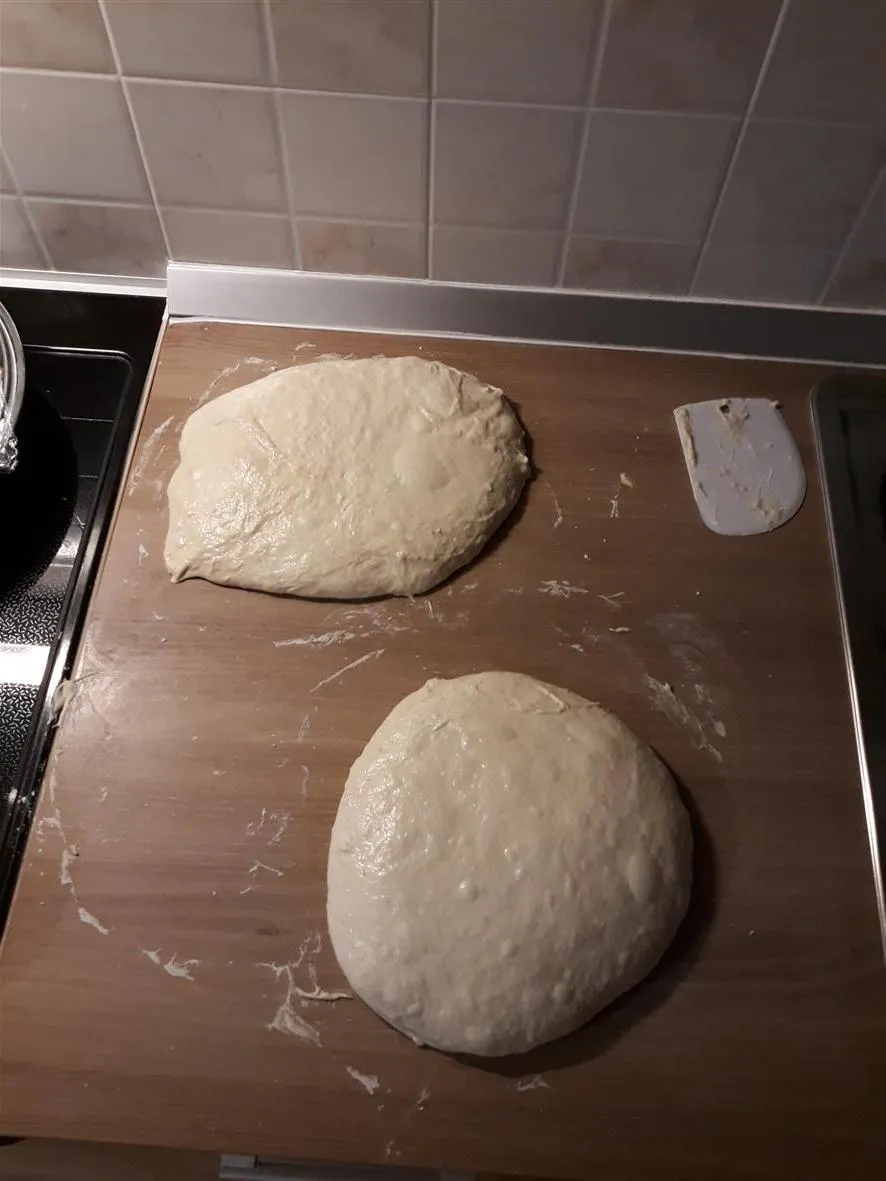
Image

Image
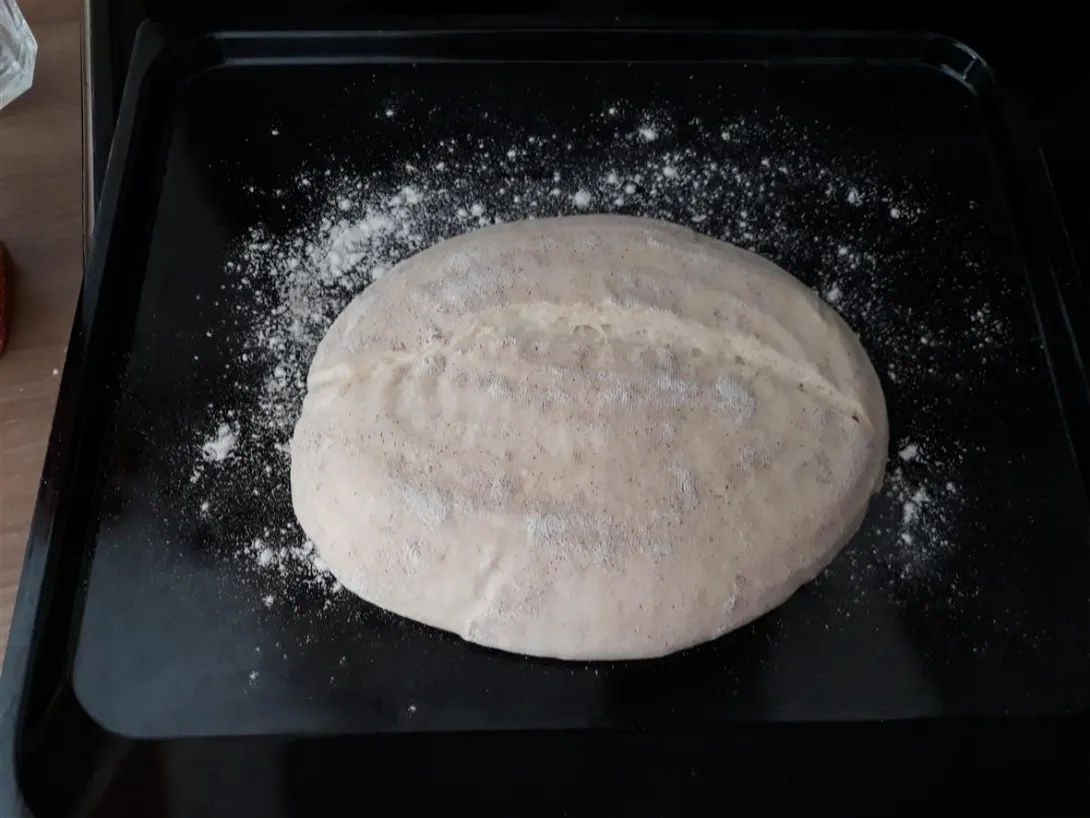
Image
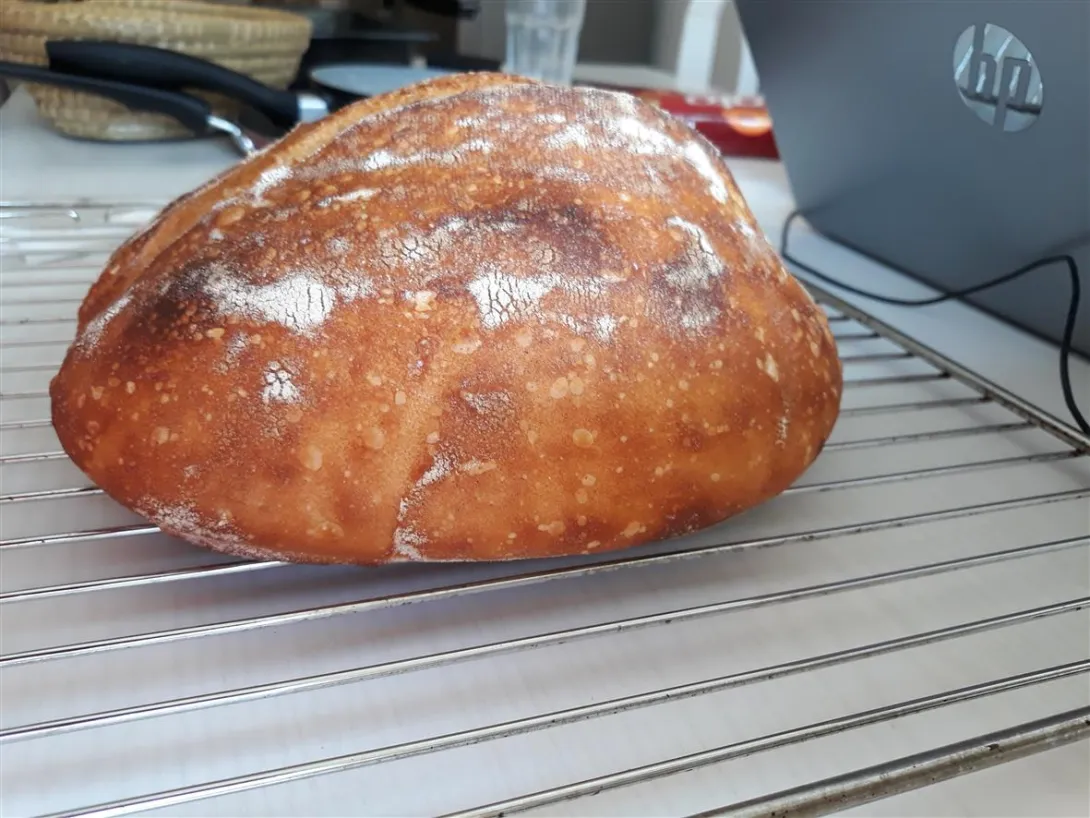
Image
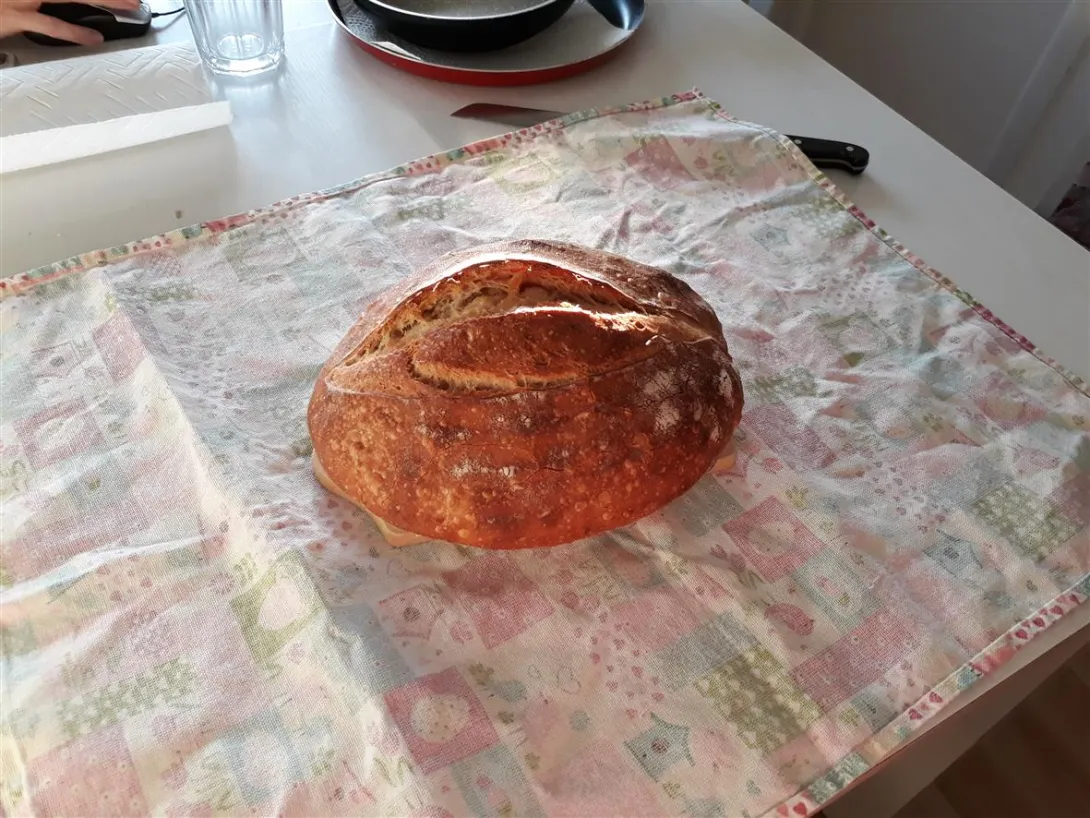
Image

After 2 h ferment:
After 18 h fridge ferment:
After initial 7 min baking:
After baking:
Crumb (nit the best picture):
I've noticed there's a lot of space in between photos, not sure how to correct that, sorry..
I wanted to attach a few more photos from my sourdough attempts:
1. attempt:
Second attempt:
Rosemary, once you see that the dough in the video looks different from yours, you know that it's because of the flour that you are using. Your flour is different. They are using bread flour, you are using all-purpose flour. They might use North-American flour in their videos, including so called 'manitoba', and you - European or of some other country/continent. Their flour is most likely dry and yours is moist and needs less water to have the same consistency. That is why I mentioned different flour as a handicap even before we start kneading.
75% hydration is high for a softer moister flour. For such flour 45-55% hydration would be normal and everything above 60% - high. Our flour in Canada is so strong and, generally speaking, rather dry that for it 70-75% is normal and anything above 90-100% is high hydration.
All pictures that you provide show such wet doughs that I bow to you. I would never be able to bake anything with that. Too wet. Yet you manage to bake pinsa and breads with that. Kudos to you!
I baked no-knead breads where all water is added at once and found no difference from the regular kneaded dough with any method of adding water whatsoever. All methods work equally well and the bread has excellent crumb and taste. The only difference is your convenience. Some people like to bake on the same day, others mix today and bake tomorrow or a week later. Some people own bread dough mixer, others don't, etc. It is all about convenience. Good bread is possible in any conditions, just find something that suits your flour and your tools or lack of them.
225C is enough to bake anything, including hearth breads and that means pinsa as well. When you use convection setting it is similar to baking at 235-240C w/o convection.
Well, I hope you found answers to your questions, "why dough doesn't get elastic and tear": (1) different flour requires different amounts of water for your dough to be 'soft' but not liquid to the point of not being able to form gluten. And (2) different flours require different approaches to let them form gluten first when dough is cold and rather dry/stiff, and then develop gluten by kneading and only later add the surplus of water in the amounts appropriate for your flour.
Depending on your flour, the difference in your amount of water with what you see on videos might comprise up to 25-30%. So, don't blindly follow, don't pour all water immediately. Measure your water and start carefully, adding less that what they do both to the first and to the second dough. Mostly watch the consistency, so that your dough looks as theirs in pictures and videos. Or else try to match their flours, use the same flours that they do.
best wishes,
m.
Thank you again mariana for all your explanations and advice, I definitely got the answers to my post's question - now it just needs some time to really sink in.
It's a bit difficult to understand it all at once (for me at least), but little by little, and with the experience I'm gaining along the way, I feel like I've come to understand what you were trying to explain :)
I never thought type of flour makes for such a difference. Sadly where I live (central EU), there aren't really types of flour that would be called 'bread' or 'strong', mostly we only have AP flour and special, purpose, flour for biscuits or doughnuts. Also the amount of protein isn't always stated on the label.
Yesterday when making pinsa/pizza with the same dough after cca 45 h or so in the fridge, the dough felt very different to handle - much easier. It wasn't as sticky as much and I could even form a boule that actually held its shape for more time. I guess this means the gluten finally developed more in the dough - lesson learned :)
Also, the structure and taste of the pizza baked on day 2 was like day/night from the one from the day before. I have to say this was one of the best homemade pizzas I've had. I'll definitely make it again - with some adjustments with the water % and see how that goes.
I've also started reviving my sourdough starter I've kept in the fridge for about 3 months - I kind of forgot about it after I moved. So I'm looking forward to start making sourdough bread again too!
Here are some pictures from the pinsa/pizza from day 2:
Image

Dough ball ready for final rising:
After 6 min baking:
Image

Image

Image
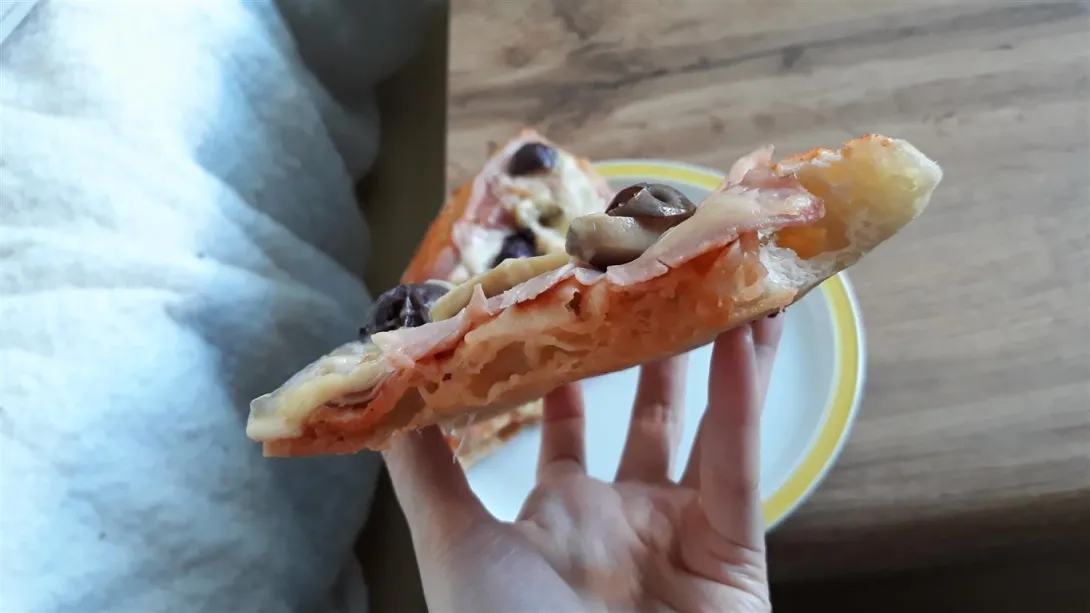
Final pinza:
Thank you again, and happy baking to you too!
Wel done, Rosemary!👍👍👍 Beautiful dough and beautiful pizza.
💖💖💖
Hi Rosemary! As Mariana has just expertly explained, flour really does make all the difference. In my anecdotal experience, I was previously using Allinson Bread Flour and having pretty average/bordering lackluster results. I found that my dough would remain super sticky and never turn out cleanly out of the bowl like I saw in so many videos no matter how many folds I did or how I adjusted temperature and time. It was really frustrating. I very recently tried to Marriage's Very Strong 100% Canadian Flour and couldn't believe the difference it made. The protein content is higher than that of Allinson. It absorbed the water so much better and the dough was so much easier to handle with no other changes made to the recipe or procedure. I'm not sure where in the world you are, but if you're in the UK, I recommend trying Marriage's or Wright's flours as a starter for ten, or perhaps looking into local millers wherever you are.
Hello CurlyBaker and thank you for sharing your experience and foundings!
I'll definitely try with lower water % next time, and try different flours. Sadly I don't think we have the flours you've mentioned so I think I'll just have to experiment with the ones we do have (: or try from the local millers as you've recommended.
Can't wait for next times baking.